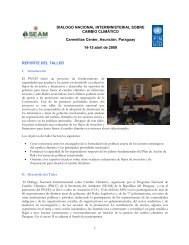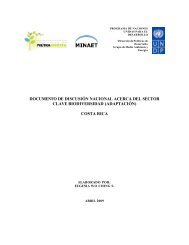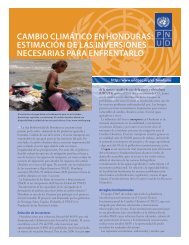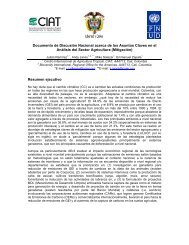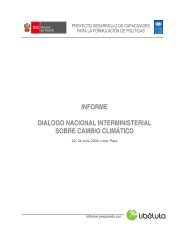View Publication - UNDPCC.org
View Publication - UNDPCC.org
View Publication - UNDPCC.org
You also want an ePaper? Increase the reach of your titles
YUMPU automatically turns print PDFs into web optimized ePapers that Google loves.
15 Cannady — Access to Climate Change Technology by Developing Countries: A Practical Strategy<br />
3. WHAT CAN WORK: A TWO-PRONGED APPROACH<br />
What can work to secure access to climate<br />
change technology for developing countries is<br />
a sustained two-pronged effort to implement<br />
climate change innovation strategy (CCTIS)<br />
in developing countries, and to enter into<br />
mutually beneficial development collaboration<br />
and IP licensing agreements between<br />
developed country companies and research<br />
institutions and their counterparts in developing<br />
countries.<br />
3.1 Climate Change Technology<br />
Innovation Strategy<br />
Innovation strategy is a medium- to longterm<br />
strategy followed by countries that<br />
have succeeded in technology development<br />
and commercialization. In brief, it is the<br />
management of national research in order<br />
to turn useful research results into an<br />
economic asset (as IP) and to facilitate the<br />
commercialization and distribution of such<br />
useful research results. In the private sector<br />
context, this discipline is referred to as “IP asset<br />
management” and is a recognized professional<br />
field. 50 In the public sector, this strategy is<br />
often referred to as “innovation strategy” or<br />
“IP strategy” and is generally implemented<br />
in parallel with national industrial policies in<br />
capitalist, socialist and mixed economies. 51<br />
Innovation strategy is not public relations<br />
relating to innovation, such as innovation fairs<br />
that often feature unprotected inventions and<br />
tout the achievements of developing countries in<br />
IP enforcement. The goal of innovation strategy<br />
must be to strengthen research, increase IP<br />
ownership by national parties, and support<br />
capacity to commercialize technologies in<br />
national, regional and international markets.<br />
The examples of two very different countries,<br />
China and Cuba, demonstrate the success of<br />
innovation strategies (Box 1).<br />
Box 1. Innovation Strategies in China and Cuba<br />
China<br />
China follows a policy that it refers to as “self-innovation” or “independent innovation”.<br />
As Premier Zhu Rongji stated in a 2003 address to the People’s Congress:<br />
We need to promote the development of a state innovation system. We should<br />
effectively strengthen our basic and high-tech research and enhance our<br />
capabilities for scientific and technological innovation and competition. We<br />
should lose no time in implementing the State Plan for High-Tech Research and<br />
Development and the State Plan for Development of Basic Research in Key Areas,<br />
as well as major projects for science and technology development. We should<br />
master core technologies and win proprietary intellectual property rights in key<br />
areas and some frontier fields of science and technology. We should strengthen<br />
the infrastructure for science and technology [author’s emphasis]. 52<br />
What is striking about this statement is the reference in the penultimate sentence to<br />
the need to “win proprietary IP rights”, clearly a strategy decision to claim ownership<br />
over technologies. What is also striking is the strategic sophistication of targeting “core”<br />
technology areas and “frontier fields”. In other words, China is building up technology<br />
ownership using IP as a tool, in order to own a technology platform. The core areas<br />
that China has sagely selected include nanotechnology, materials science and storage<br />
(batteries), three critical platforms for climate change technologies. Ownership of patent









